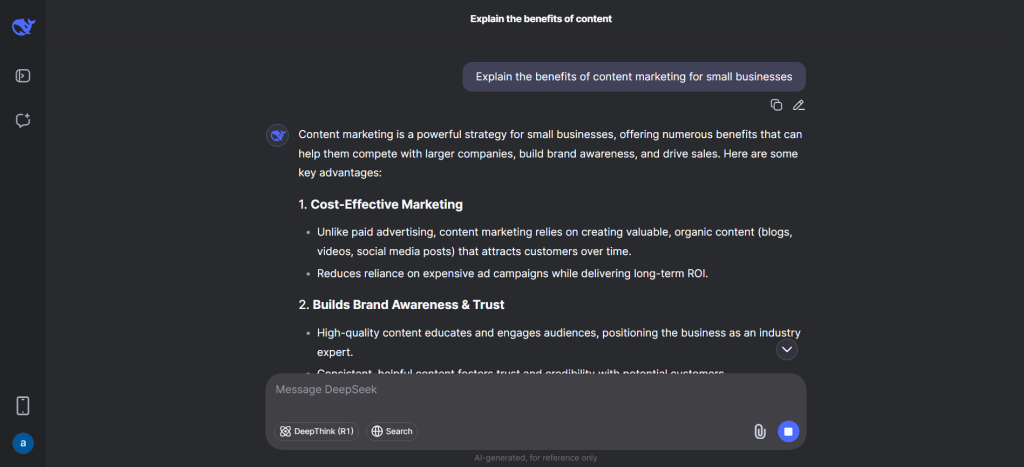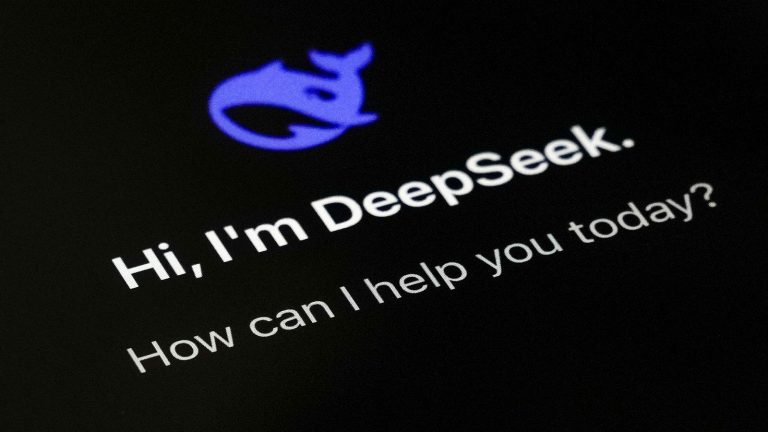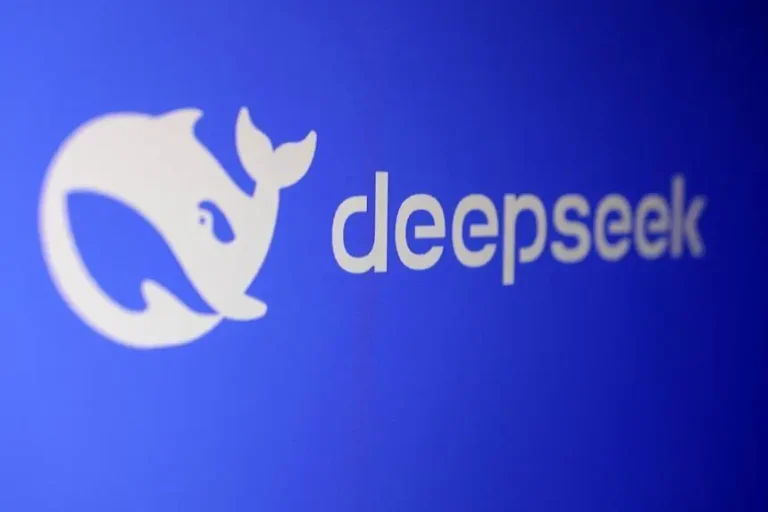DeepSeek is a cutting-edge AI writing assistant and large language model (LLM) platform designed to help content writers create high-quality, SEO-optimized content. Since its launch, DeepSeek has quickly gained popularity – even surpassing established AI tools like ChatGPT in downloads.
Powered by an advanced AI model (DeepSeek-R1) with over 600 billion parameters, it delivers performance on par with top-tier international models. For marketers, bloggers, and professional writers, DeepSeek offers a professional yet accessible way to enhance content creation.
In this article, we’ll explore how DeepSeek supports content writers by producing natural, fluent text, generating creative ideas (headlines, hooks, introductions), and assisting with SEO optimization (keyword suggestions, content structure, readability).
What is DeepSeek? An AI Assistant for Content Writing
DeepSeek is an AI-driven writing assistant platform that leverages a powerful LLM to generate human-like text. Developed by a forward-thinking startup, this tool has rapidly become a go-to solution for content writing tasks. Users can access DeepSeek via a web interface, mobile app, or browser extension to get real-time writing support.
The AI model behind DeepSeek (named DeepSeek-R1 or V3) boasts impressive capabilities – it can understand context, reason through complex prompts, and produce coherent responses across various topics.
In practice, this means DeepSeek can help authors draft articles, answer questions, and even solve problems with ease. The platform’s language fluency is a key strength: in head-to-head comparisons, DeepSeek has been praised for providing well-structured, fluent outputs that match a human writer’s logic and tone.
Why does DeepSeek stand out as an AI writing assistant? For one, it combines open-ended creativity with task-oriented focus. Writers can ask DeepSeek anything from brainstorming topics to refining a final draft. The AI’s massive training data and sophisticated architecture enable it to write in natural, conversational English that feels authentic and engaging. Unlike some generic tools, DeepSeek is tuned for content creation needs – it excels at maintaining structure and clarity in longer pieces. In short, DeepSeek serves as a digital co-writer, offering the benefits of an intelligent assistant that’s available 24/7 to help you write better content faster.
Writing in Natural and Fluent Language with DeepSeek
One of the biggest advantages of DeepSeek for content writers is its ability to produce natural and fluent language. Thanks to its advanced LLM (with hundreds of billions of parameters), DeepSeek generates text that reads as if it were written by a human. Grammar, tone, and style are handled gracefully, allowing writers to maintain a professional yet accessible voice in their articles. In fact, DeepSeek’s outputs are often well-structured and contextually relevant, demonstrating logical flow in paragraphs and sections. This means you can trust DeepSeek to draft blog sections or even full articles that require minimal editing for clarity.
For example, if you provide DeepSeek with a prompt like “Explain the benefits of content marketing for small businesses”, it will generate a coherent, multi-paragraph response with a clear introduction, supporting points, and conclusion.

The language will be fluent and easy to read, free of awkward phrasing that plagues some AI tools. This natural writing style is invaluable for keeping readers engaged and ensuring your content meets a high quality bar. Many users have noted that DeepSeek’s answers not only cover the essentials but also mirror a human writer’s reasoning process – the AI can outline its thought process and ensure each point is well-explained. The end result is content that sounds human, preserving your unique voice while eliminating time-consuming drafting work.
Moreover, DeepSeek allows you to adjust the tone and formality of the output. Whether you need a casual blog post, a technical article, or a persuasive marketing piece, you can instruct the AI accordingly. The model’s training on diverse writing styles helps it adapt to your desired tone. Ultimately, DeepSeek’s fluent language generation enables content writers to produce polished drafts quickly, which can then be fine-tuned with personal insights or brand voice. It’s like having a skilled writing assistant who never runs out of energy or inspiration.
Generating Ideas: Headlines, Hooks, and Introductions
Writer’s block and lack of fresh ideas are challenges every content creator faces. DeepSeek addresses this by acting as an idea generator for headlines, hooks, and introductions. Using DeepSeek, you can brainstorm captivating headlines or blog titles tailored to your topic and keywords. Simply by prompting the AI with your subject area, DeepSeek will suggest multiple title options that are both creative and SEO-friendly (it even considers character limits for title tags). For instance, marketers can ask for “engaging blog post titles about email marketing trends” and get back a list of catchy headlines to choose from.
Beyond titles, DeepSeek helps craft the all-important hook or opening lines of an article. The introduction needs to grab attention and summarize what’s to come – DeepSeek can draft this for you. By feeding it a prompt like “Write an introduction for an article about the importance of AI in SEO content”, the AI will generate a compelling opening paragraph. It often starts with a relatable scenario or a thought-provoking question, drawing readers in naturally. Many content writers use DeepSeek to experiment with different hooks until they find the one that resonates best with their audience.

DeepSeek’s strength in idea generation extends to outlining entire introductions and section openers. It ensures that each intro transitions smoothly into the content. For example, if writing a guide on “how to write with DeepSeek,” you could ask the AI for a few opening sentences that set the stage. The result might be a hook that highlights a common pain point (like struggling with content drafts) and introduces DeepSeek as the solution in a friendly, enticing way. By leveraging DeepSeek for headlines and hooks, writers save time and inject more creativity into their work. The AI essentially serves as a brainstorming partner who can churn out endless possibilities – you can then refine and select the best options for your article.
SEO Optimization with DeepSeek: Keywords, Structure, and Readability
In today’s digital landscape, content needs to be not only well-written but also optimized for search engines. DeepSeek shines as an AI SEO content tool by assisting writers in creating SEO-friendly content without sacrificing quality. Here’s how DeepSeek supports SEO optimization:
- Keyword Suggestions: DeepSeek can help identify and incorporate relevant keywords seamlessly into your writing. By providing the AI with a main topic or focus keyword, it can suggest related long-tail keywords and phrases to include in your article. For instance, if your primary keyword is “email marketing strategies,” DeepSeek might recommend related terms like “newsletter engagement tips” or “email campaign best practices” to enrich your content. Using prompts, content writers have successfully generated keyword lists and variations with DeepSeek. This ensures your article covers the semantic field of the topic, which is great for SEO.
- Optimized Content Structure: DeepSeek helps organize articles in a logical, SEO-friendly structure. It can generate content outlines that include proper headings (H2, H3) and subtopics, ensuring you cover important points that search engines (and readers) expect to see. In fact, DeepSeek is known for its logical structuring – it provides well-structured, task-oriented responses. You can ask DeepSeek for an outline on a given topic, and it will break down the article into sections with suggested headings. These outlines often align with how an experienced writer would plan the piece, covering definitions, how-to steps, benefits, examples, FAQs, etc. This not only helps you as the writer to organize your thoughts, but also improves SEO, since a clear structure with relevant headings can improve readability and crawling. DeepSeek even follows guidelines about focusing on readability and keyword placement in outlines, meaning the suggested structure will cater to both human readers and search algorithms.
- Readability and Tone: Content that ranks well is typically easy to read and provides value to the audience. DeepSeek can write in a concise and reader-friendly style, which boosts readability metrics like Flesch Reading Ease. If you need to simplify a complex explanation or shorten sentences, DeepSeek can rephrase content to be clearer. You can also specify a desired reading level or tone (e.g., “explain like I’m 5” or “use a professional tone”), and the AI will adjust the output accordingly. By maintaining an active voice and varying sentence length, DeepSeek’s generated text tends to be engaging and digestible. Additionally, DeepSeek can help with crafting elements like meta descriptions or FAQs that improve SEO. For example, you might ask it to “write a 150-character meta description for an article about AI writing assistants”, and it will produce a concise, keyword-rich snippet ideal for search engine result pages (SERPs). It can also suggest frequently asked questions (and answers) about your topic, which you can include to target featured snippets or the People Also Ask section.
By using DeepSeek as an AI SEO content tool, writers can effortlessly integrate keywords, maintain good structure, and ensure high readability – all of which contribute to better search ranking. Importantly, DeepSeek’s suggestions help you optimize content without resorting to keyword stuffing. The focus remains on addressing user intent and providing comprehensive information (a practice that DeepSeek also emphasizes, given its ability to understand context and intent). This means your content will appeal to readers and search engines alike, striking the perfect balance between quality and optimization.
Workflow Example: How to Write with DeepSeek
To illustrate DeepSeek’s support for content writers, let’s walk through a typical content creation workflow using DeepSeek (a hypothetical example that mirrors real usage):
- Topic Brainstorming: Imagine you need to write an article about “benefits of remote work for productivity.” You start by asking DeepSeek for blog post ideas or angles on this topic. Prompt: “Give me five engaging blog post ideas on the benefits of remote work for productivity.” DeepSeek responds with several creative angles, such as “Top 7 Ways Remote Work Boosts Productivity (Backed by Data)” or “Remote Work vs Office: Why Productivity Soars When Working from Home.” This helps you choose a compelling angle for your article. (DeepSeek saves you time by quickly generating blog ideas tailored to your keyword.)
- Outline Creation: After picking an angle, you ask DeepSeek to outline the article. Prompt: “Generate a detailed content outline for an article titled ‘Top Benefits of Remote Work for Productivity’ with SEO in mind.” DeepSeek then produces a structured outline with an introduction, headings for each key benefit (e.g., fewer distractions, flexible scheduling, improved work-life balance, etc.), and a conclusion. Each section comes with sub-points or notes on what to cover. The outline is logically ordered and ensures you won’t miss important subtopics. (Notably, in one comparison, DeepSeek’s outlining ability even included points a human writer planned to cover but other AI missed, underscoring its thoroughness.)
- Draft Writing: With the outline as a guide, you proceed to draft the article. You can write paragraphs yourself or have DeepSeek assist with drafting. Many writers use a hybrid approach: write a rough draft and then have DeepSeek expand or refine certain sections. For example, if you struggle to articulate one benefit, you could prompt: “Expand on how flexible scheduling in remote work improves employee productivity.” DeepSeek will generate a paragraph explaining that benefit in fluent detail, perhaps noting that employees can work during their most energetic hours, thereby accomplishing more. You incorporate this into your draft, editing as needed to match your voice. DeepSeek’s content tends to require light editing, as it’s already well-phrased and coherent.
- SEO Enhancement: Once the draft is complete, you review it for SEO. You ask DeepSeek to check for any keyword opportunities you might have missed. Prompt: “Suggest 5 related keywords or phrases to include in this article about remote work productivity.” DeepSeek might suggest terms like “remote work efficiency,” “telecommuting benefits,” or “productivity tools for remote teams,” which you can naturally weave into the content. You also request a meta description: “Write a meta description (~150 characters) highlighting the article’s key point on remote work and productivity.” DeepSeek provides a concise meta description that you can use or tweak (e.g., “Discover how remote work boosts productivity – from fewer office distractions to flexible schedules – and why companies see better results.”). Additionally, you might have DeepSeek generate a few FAQ questions related to the topic (for instance: “Does working from home increase productivity?”) along with brief answers. These can be added to the article to target common reader queries.
- Editing and Final Touches: Finally, you read through the article, using your own expertise to fact-check and ensure the tone is perfect. DeepSeek’s content is solid, but you add your personal anecdotes or specific stats where needed. The AI may have provided the bulk of the text, but as a responsible writer you ensure everything is accurate and aligns with your brand voice. Perhaps you also use DeepSeek to simplify any overly complex sentences (just to improve readability). Once satisfied, you have a polished, SEO-optimized article ready to publish.
In this workflow, “how to write with DeepSeek” becomes a straightforward process of collaboration. The AI handles the heavy lifting for idea generation and initial drafting, while you guide it with prompts and refine the output. Writers often report that this synergy not only speeds up content production but also improves the quality of the final piece – you’re less likely to overlook key points or SEO elements when DeepSeek is part of your process. By following a similar workflow, content creators can leverage DeepSeek to consistently produce well-researched, engaging, and search-friendly articles with less stress and more creativity.
Conclusion: Empowering Content Writers with AI
DeepSeek demonstrates how an AI writing assistant can empower content writers in the digital age. It functions as both a creative partner and an AI SEO content tool, covering the spectrum from initial content ideation to final optimization. By writing in natural and fluent language, DeepSeek helps authors maintain a high-quality standard without spending endless hours on drafts. Its ability to generate headlines, hooks, and introductions sparks creativity and ensures every article starts strong. Furthermore, DeepSeek’s support for SEO – from suggesting keywords to structuring content effectively – means your writing is primed to rank well and reach a larger audience.
Adopting DeepSeek in your writing workflow can lead to faster content production and more effective content marketing. Marketers and bloggers benefit from the time saved on research and brainstorming, allowing them to focus more on strategy and personal touches. Professional writers appreciate that the AI can handle repetitive or technical parts of writing (like formulating SEO meta tags or checking for content gaps) while they concentrate on craft and accuracy. Of course, human oversight remains important – DeepSeek provides the draft, but it’s the writer’s job to review, fact-check, and fine-tune the output. When used wisely, DeepSeek is a powerful co-author that enhances your capabilities rather than replacing them.
In summary, DeepSeek supports content writers by combining the strengths of advanced AI (speed, data-driven insights, language mastery) with the needs of modern content creation (originality, SEO alignment, audience engagement).
Whether you’re wondering how to write with DeepSeek for your next blog post or looking to boost your SEO content strategy, this AI assistant offers a user-friendly platform to elevate your writing process. Embracing tools like DeepSeek can keep you ahead in the evolving landscape of content writing and SEO, where quality and optimization go hand in hand.


